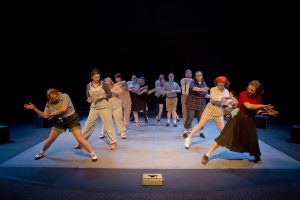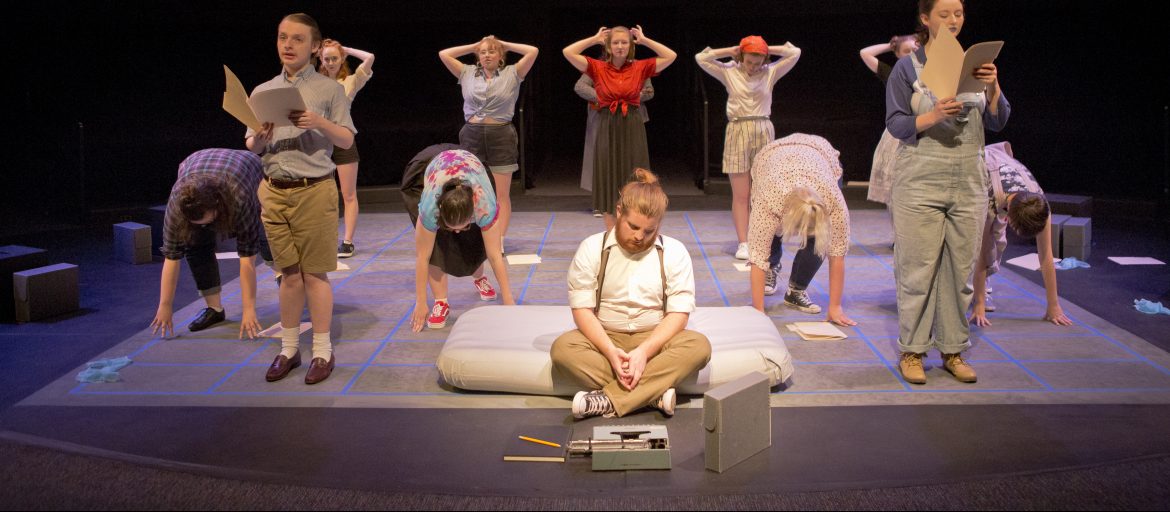UNC Asheville students—15 of them—are heading to Edinburgh, Scotland in August to perform at the famous Festival Fringe and they’re taking nothing with them. To be more precise, they are taking almost nothing, and also, Nothing.
The almost nothing could almost fit in a big suitcase. It consists of a violin, an old typewriter, a few archive boxes, a small mattress, a few folders and papers, and a roll of tape to mark a grid on the stage floor in a totally set-free production. These few props were chosen by the student actors to help them summon forth students from 70 years ago at Black Mountain College (BMC) in vignettes, interruptions, songs, and choreography—all original—in a work of devised theater they will perform at Festival Fringe.
The larger, overarching Nothing is the structure, backbone, and verbal backdrop of the performance. It is John Cage’s famous Lecture on Nothing, chosen by director Leon Ingulsrud as the inspiration and canvas for the original student creations. Ingulsrud, co-artistic director of New York City’s SITI Company, was UNC Asheville’s spring 2019 Black Mountain College Legacy Fellow, and he worked intensively with the students, starting with four-hour long work sessions in January.
inspiration and canvas for the original student creations. Ingulsrud, co-artistic director of New York City’s SITI Company, was UNC Asheville’s spring 2019 Black Mountain College Legacy Fellow, and he worked intensively with the students, starting with four-hour long work sessions in January.
As training for the students, Ingulsrud used two different techniques. One was “Viewpoints” from the postmodern dance world, “a way of getting in touch with the space and your body, while also being able to maintain emotion,” said Casey Clennon ’19, a drama major who provides sound direction in addition to performing. The other was “Suzuki,” not the approach to musical training but a technique from a Japanese theater company which Ingulsrud leads with commands like those of a martial arts instructor. These techniques are not styles of acting, says Ingulsrud, but rather, methodologies of actor-training, “looking at acting as potentially virtuosic.”
“We always leave a little sweaty because it’s super physical, but it’s been one my favorite processes working in the Drama Department,” said Clennon. “I’ve learned a lot in a really short period of time.”
During their first week of work, the students and Ingulsrud went together to find remaining pieces of the past in the Black Mountain College collection of the Western Regional Archive, located in East Asheville. In some senses, Black Mountain College is truly gone and there is next-to-no video of its classes or performances. But the college, which operated between 1933 and 1957 at Lake Eden where the LEAF Festival is now held, engaged leading artists, scientists and other scholars in interdisciplinary study and a spirit of intellectual exploration that has left indelible marks on today’s culture.
As part of its ongoing partnership with the Black Mountain College Museum + Arts Center in downtown Asheville, UNC Asheville hosts the ReVIEWING Black Mountain College Conference each fall. And for the past three years, the university’s Black Mountain College Legacy Fellows program has engaged the campus in BMC’s spirit of fearless intellectual exploration. Last year, BMC Legacy Fellow Jonathan Keats led students in creating a concert with a variety of stimuli that might reach human and non-human creatures on this planet and beyond; and BMC Legacy Fellow Mel Chin worked with students to create the largest art installation ever in New York City’s Times Square.
The Black Mountain College Legacy Fellows Program is funded through a $180,000 grant from the Windgate Foundation and UNC Asheville’s partnership with the Black Mountain College Museum + Arts Center.
I have nothing to say and I am saying it and that is poetry as I need it.
-Excerpt from the Lecture on Nothing by John Cage
“So many things, people and ideas trace back to Black Mountain College—so many artists of my generation have seen it as this magical place,” said Ingulsrud. “And the undergrads have some of that sense too, but they related very much to the day-to-day of what these students were going through—they had this very human, very direct reaction.”
“There are these amazing scrapbooks where they saved everything that was ever posted on the bulletin boards—tiny notes and little things,” said Ingulsrud after the visit to the archive. “The students immediately dove into this saying, ‘oh, this is like a meme,’ … really seeing how their peers in that time were responding in the same ways, even with vastly different technology.”
The culmination of this exploration into intellectual history, combined with Ingulsrud’s training and a broad artistic license, is a 70-minute performance titled Nothing’s Happening—A Black Mountain College Project, which previewed with four performances in April in Belk Theatre on campus. It’s a juxtaposition of Cage’s abstract, philosophical lecture—“Even though it’s a lecture about nothing, it’s also about everything,” says drama major Caroline Kelly ’19—with down-home elements of the students’ own creation, like Appalachian vocal harmonies, vignettes, and quotes sharing the ordinary lives of students, pulled from the archival remains BMC.
The last time the Lecture on Nothing received large-scale public performances, the Los Angeles Times found it “charming, often amusing, often quotable, equally often infuriating and profoundly thought provoking.” The Lecture was staged in Europe and the U.S. as part of the John Cage centenary celebration in 2012-13.
And now, in this quite ambitious undertaking, the work is being brought back to Europe by UNC Asheville students. “This experience is so new for many of them—they’ve never done anything like it before,” said Lise Kloeppel, associate professor of drama, who will conduct a three-day “boot camp” in late July to ready the students for their Festival Fringe performances and then accompany them to Edinburgh. “The work of Black Mountain College was exploring form first and then content, and that’s what we’ve been doing. A lot of the theater our students are used to doing and seeing is really about content—a narrative.”
So it makes sense that the students’ creation, Nothing’s Happening, became a combination of Cage’s abstractions and ruminations on form, with tangible things the students found in research about BMC that they could relate to more directly. “Sifting through the Black Mountain College archives was like digging through treasure chests,” wrote Morgan Fuller ’19, a double-major in drama and mass communication, in a blogpost about the process of creating Nothing’s Happening.
“Staring at a list of names like Merce Cunningham, Robert Rauschenberg, the de Koonings, Buckminster Fuller, and John Cage, among many more, is a little intimidating. So many geniuses and incredible people came out of the college, I felt uncertain of how I could possibly relate to them,” wrote Fuller. “But visiting the archives offered a glimpse into the lives behind the big names. I saw the notices of cast lists from their bulletin board. I found memos and old school papers. I even read the love letters between a student and her boyfriend. This last one really captured my attention.”
And so the Snapchat generation brought a manual typewriter and a generations-old snail-mail love letter into their production. The archivist who guided their explorations also became a character. And complaints from the BMC bulletin board about missing items compete for audience attention with Cage’s metaphoric language about harmony and dissonance, and his repetitive narrating of the structure of his lecture.
Putting aside Cage’s challenge to the nature of knowledge, the students certainly were working. To prepare for the equivalent of the off-Broadway performances before the main show—the ones where the Asheville community could come to the exclusive preview in Belk Theatre, the student troupe had a total of six weeks with Ingulsrud, working four-hours a night, five nights a week in addition to the rest of their classes and jobs, to develop and hone Nothing’s Happening.
We need not destroy the past. It is gone.
-Excerpt from the Lecture on Nothing by John Cage
At the beginning of the process, Ingulsrud felt it was important to give the students a basic structure for their performance. “It’s difficult and not always productive to start with a completely blank slate,” he said. “John Cage’s Lecture on Nothing which I brought in as a backbone, for me brings enough poetry, enough beauty, enough to think about, to sustain. But I want that to be a spine on which we hang other things that intersect with it, interrupt it, coexist with it, while at the same time, performing the Lecture on Nothing at a level that will be satisfying.”
The Lecture, with its repetition and its precisely scripted odd meters, is challenging in form as well as content, and Ingulsrud, with his difficult and structured technical practices, challenged the students to grow as performers. But in the spirit of what he calls John Cage’s “toppling of hierarchies,” Ingulsrud gave the students totally free rein to develop the added choreography, music, vignettes, and more. What has resulted is that “the ingredients of the piece set up certain collisions that we didn’t resolve.”
“My hope is that the audience feels free to be as confused as I am,” said Ingulsrud, after watching the first preview performance. “There’s something there and we don’t do that enough in the theater. Theater makes too much sense too much of the time, and it leads us to the illusion that life makes sense, and there is a certain pleasure in being nowhere. I think that’s what Cage is trying to tell us. And I think Black Mountain College understood that pretty deeply.”
I sometimes think I know something, but when I am working it is quite clear that I know nothing.
-Excerpt from the Lecture on Nothing by John Cage
“I hope that in Scotland, they’ll have just as much fun as the audience on campus if not more. A lot more people are aware of Black Mountain College outside of this area, which is very interesting to me,” said Rebecca Boyce ’20, UNC Asheville’s Black Mountain College Legacy Intern and one of the performers. “In Edinburgh, I know a lot of people will be coming out specifically for the Black Mountain College content. Hopefully, they might find more appreciation in some of the little nuances of what John Cage wrote, or inside jokes about Black Mountain College that this crowd may not have picked up immediately.”
While UNC Asheville’s students are bringing back to life (and to Europe!) an old work, their performance is far more than a theater revival. They have started with literally Nothing, and fueled by the inspiration of the now-renowned students, artists, and thinkers who once gathered at nearby Lake Eden, they will bring the global audience at Festival Fringe everything they’ve got.
Students are even paying part of their own way for the 11-day trip to Scotland, with the university contributing part, along with help from one large anonymous donation and many small ones from donors who contributed to an online crowd-funding campaign, and who put cash in the open violin case left on the stage after each Belk Theatre preview performance.
A finished work is exactly that, requires resurrection.
— Excerpt from Forerunners of Modern Music by John Cage
“It’s going to be amazing and I look forward to seeing what’s going to happen to these UNC Asheville students going to Edinburgh’s Festival Fringe and getting their minds blown by the richness of what’s out there,” said Ingulsrud. “I really want to see what UNC Asheville students are uniquely going to do with that experience that other students wouldn’t do. I think that’s tremendously exciting and worth supporting.”
